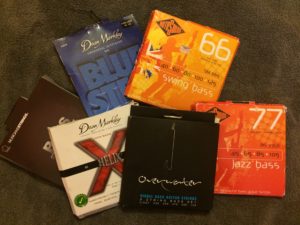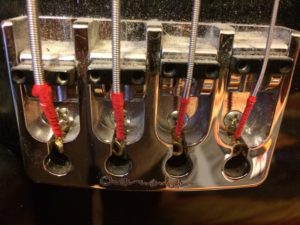Mark Nisbet
All about Mark Nisbet and his music
Playing
Bass Setup
How your bass is set up will make a lot of difference to how easily it can be played or in fact whether it can be played in tune at all. A new or second hand bass bought from a reputable shop should come ready set-up but this may not be the case with an instrument bought over the internet. Most second hand instruments will have been set up properly at some point by or for the previous owner but over time things need adjusting and this may not have been done.

Strings
bass strings fortunately do not usually requiring changing anything like as frequently as those on guitars, generally bass strings are however considerably more expensive. New strings have a much livelier sound that some like but does not suit all tastes. Some bassist leave strings in place for years as they like the more rounded less twangy sound. This can also be acheived to some extent by using flat wound rather than round wound strings.
If a guitar has been left unplayed for a long time it is possible for strings to rust. If this has happened then they will definitely need to be replaced.

Intonation
In theory on a bass guitar strings of equal length produce different frequencies due to increasing thickness and specific tension created by the tuners. This works perfectly for open strings but can cause an issue when notes are fretted particularly as notes get higher. If a bass is correctly set up the harmonic at the twelfth fret will be exactly an octave above the open string and exactly the same as the note achieved when a finger is placed on the fingerboard at that position. Unfortunately due to the physics of sound generation this will not be the case if the part of the strings free to vibrate are all the same length. Thus is why most bass guitars allow you to fine tune the length of the string to correct this, that is why the bridge saddles can be moved backwards and forwards.
Action
This is the distance between the top of the frets and the bottom of the strings. Action is usually lowest at the top end by the nut and highest at the bottom of the neck towards the bridge but the aim of a good set-up is to make this difference as small as possible.
If the action is too high the bass will be hard to play and intonation will be a big problem as strings are being pushed so far as they are played. If the action is too low the strings will vibrate against the top of the frets or even worse the pickups, creating buzzing. Ideally the action should be set as low as possible without the strings buzzing when any fret is fingered though some prefer a higher action and so personal preference comes into play.
Three factors impact on the action, the nut, the bridge and the truss rod. The bridge controls the height at the end of the body and this can usually be adjusted by turning individuals screws for each string. The truss rod acts to straighten the neck against the pull of the strings, it is relatively easy to adjust but care should be taken with small incremental adjustments as it is possible to over do it and break the neck. Adjustment is generally by Allen Key and access is gained at the top or the bottom of the fingerboard often by removing a small cover with three or four little screws. The nut is not easily adjustable, it can be removed and sanded down but this is a job best performed by those with experience.